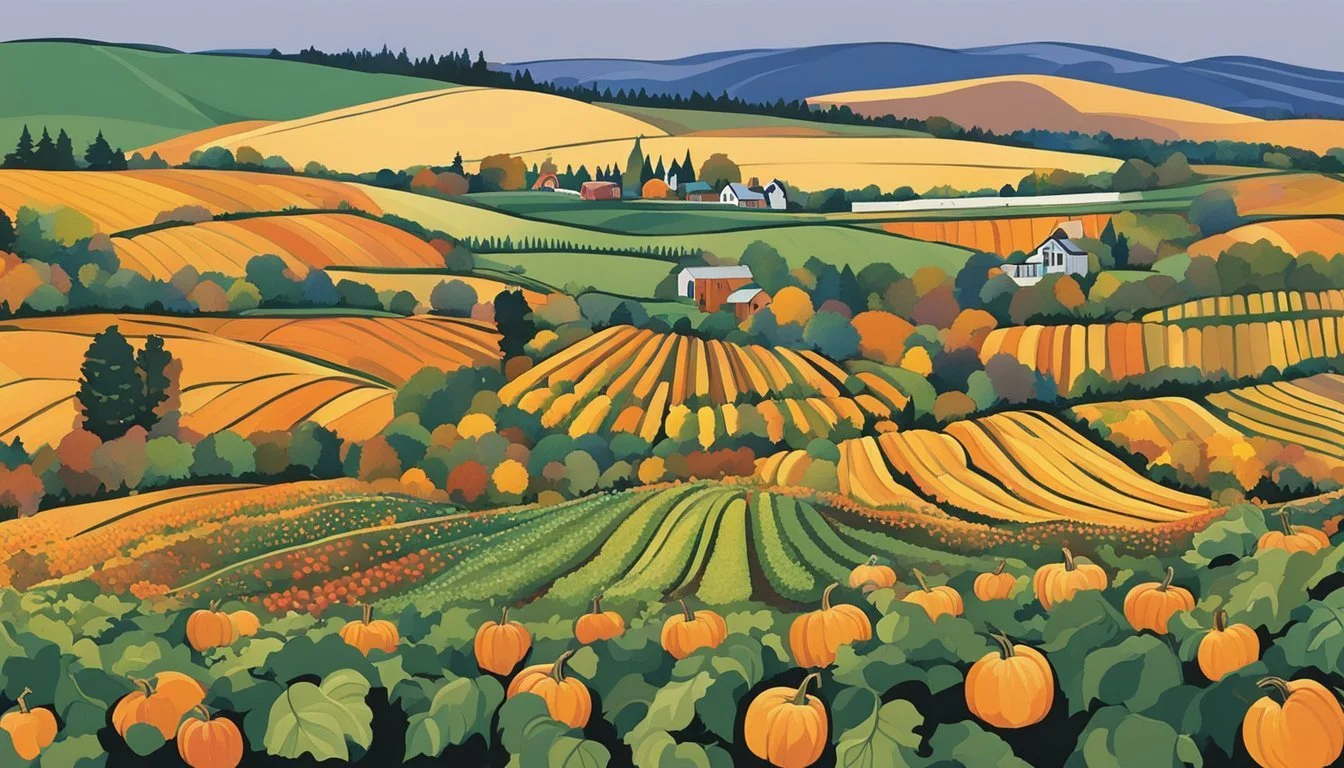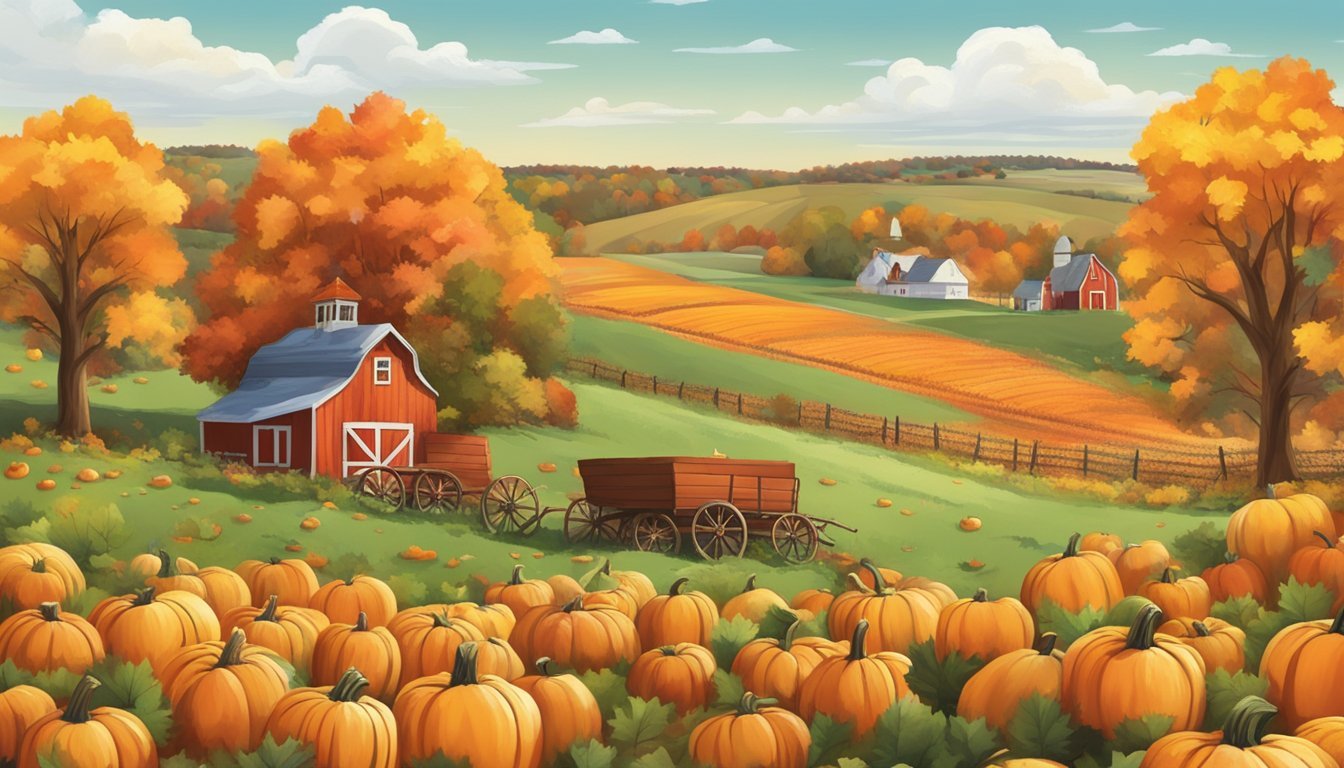North Dakota Seasonal Fruit & Vegetables in October
Your Guide to Autumn Harvest
This Article is Part of our North Dakota Seasonal Fruit & Veg Calendar
In North Dakota, the month of October is a transitional period where the remnants of summer harvests meet the beginnings of the autumn bounty. This time of year is characterized by a diverse variety of fresh produce, ensuring that the seasonal offerings are both abundant and flavorful. The state's agricultural landscape yields a rich harvest of both fruit and vegetables that are at their peak in terms of freshness and nutritional value.
Seasonal fruit available during October includes apples (how long do apples last?), which are a staple in the North Dakota harvest with numerous varieties available. Local farmers also gather late-season blackberries, which by October have become sweeter and less tart, making them a perfect addition to fall recipes or for enjoying fresh. These fruits are complemented by an assortment of vegetables such as radicchio known for its distinctive flavor and versatile use in autumnal salads and dishes.
As the temperatures begin to drop, root vegetables also become more prominent in the North Dakota harvest. October sees an increase in the availability of produce such as pumpkins, which are not only emblematic of fall but also packed with nutrients. The state's fertile soil and favorable growing conditions contribute to the quality and taste of these seasonal offerings, allowing residents and visitors alike to experience the full palate of autumn's harvest.
Benefits of Eating Seasonal Produce
Seasonal produce refers to fruits and vegetables that are naturally ready for harvest at a particular time of the year. Each season brings different varieties to the forefront, especially during the fall in regions like North Dakota. Consuming these foods in their prime not only supports local farms but also maximizes the sensory experience of eating.
Freshness: Seasonal fruits and vegetables are often fresher, having been harvested at the right time. They are typically sold shortly after being picked, which helps maintain their nutritional value.
Flavor: Fresh produce tastes better. When fruits and vegetables are allowed to ripen on the plant and are harvested at the right time, they develop a full, robust flavor. Fall harvests in North Dakota include crisp apples, rich pumpkins, and hearty root vegetables.
Nutrition: Seasonal fruits and vegetables can be more nutritious. The peak season allows for the highest level of natural nutrients, as the produce hasn't been stored for long periods or transported over long distances.
Supporting Local Farms: Purchasing seasonal produce helps support regional agriculture and the local economy. Buying directly from farms or local markets ensures that the money spent contributes to the area's financial health.
Environmental Impact: Less distance between farms and consumers means reduced carbon footprint from shipping foods across vast distances. Seasonal eating often implies a reduction in the energy and resources required for transportation and storage.
By considering the seasonality of fruits and vegetables, consumers can enjoy an array of benefits ranging from taste to economic support for their region. Fall in North Dakota offers a unique selection of harvest-ready produce, ideal for those looking to enrich their dietary palette while contributing to their community and environment.
Seasonal Fruits Available in North Dakota
In North Dakota, October brings a harvest of fruits that are ripe and rich with flavor. Orchards and farms offer a vibrant array of fruit that's perfect for autumnal recipes or enjoying fresh.
Apples
One of the most versatile fruits, apples come into full swing in October. Varieties range from Granny Smith, known for its tartness, to Fuji, which is sweeter and crisp. These apples are ideal for numerous dishes, including pies, sauces, and ciders. Their colors vary from vibrant reds to greens, making them a picturesque addition to any seasonal display.
Typical Apple Varieties in October:
Granny Smith: Tart and firm, great for baking.
Fuji: Sweet and juicy, perfect for eating raw.
Pears
Pears are another fruit that hit their peak in October. They transition from green to a soft yellow when ripe. Their sweet flavor makes them excellent for both eating fresh and incorporating into desserts.
Pear Selection Tips:
Choose pears that are firm to the touch with a slight give near the stem, indicating ripeness.
Cranberries
Although more commonly associated with wetlands in other states, North Dakota does see a seasonal yield of cranberries in October. They are typically tart and can be used fresh, dried, or juiced for various culinary applications, often paired with sweeter fruits or used in festive dishes.
Cranberry Uses:
Fresh: In salads or relishes
Dried: As a snack or in baking
Juiced: In beverages or sauces
Plums
Coming to the end of their season in October, plums offer a sweet and slightly tangy flavor. They are enjoyed fresh, turned into jams, or baked into desserts. The deep purples and reds of plums add a burst of autumnal color to the North Dakota fruit selection.
Plum Highlights:
Sweet with a hint of tartness
Ideal for jams and baking
North Dakota's October fruits provide a sweet bounty perfect for a variety of apple recipes and beyond.
Seasonal Vegetables to Enjoy
In October, North Dakota offers a rich harvest of vegetables that thrive in cooler temperatures. This affords a great opportunity to incorporate a variety of nutritious and flavorful options into one's diet.
Root Vegetables
Root vegetables are at their best in October. The cooler weather allows for a sweeter taste as the vegetables convert starches into sugars.
Sweet Potatoes: A versatile staple with a rich, sweet flavor.
Potatoes: Ideal for a range of dishes from mashed to roasted
Beets (how long do beets last?): Known for their earthy sweetness and deep red hue.
Winter Squash
Squash varieties available in North Dakota are perfect for hearty autumn meals.
Pumpkins: Beyond carving, they're great for soups and pies.
Butternut Squash: (how long does butternut squash last?) With a sweet, nutty taste, it's excellent when roasted or puréed.
Leafy Greens
Cooler October temperatures in North Dakota enhance the flavor of leafy greens, making them less bitter and more tender.
Kale: A nutritious green that's great for salads and chips.
Radicchio: Its vibrant color and slight bitterness add character to salads.
Cruciferous Vegetables
These vegetables are known for their health benefits and are in peak season during October.
Broccoli: Best when steamed or sautéed, retains its nutrients and flavor.
Brussels Sprouts: When roasted, they develop a caramelized, nutty flavor.
Cabbage: Ideal for slaws and ferments, like sauerkraut (how long does sauerkraut last?).
Harvesting and Storage Tips
Harvesting
October is a robust period for harvesting in North Dakota, marked particularly by late-season crops. Apples, are in full swing, and should be picked when firm and fully colored. For root vegetables such as carrots and beets, they can be harvested when they reach a suitable size and flavor intensity.
Produce like pumpkins and squashes should be harvested before the first heavy frost, with stems left intact to prolong shelf life. Berries such as blackberries, when left on the bush until October, become sweeter and can be gathered before the frost arrives.
Storage
Appropriate storage extends the life of the harvested produce. Many vegetables can be kept in a cool, dark place. For example, potatoes, carrots, and beets may be stored in a root cellar or similar environment with high humidity to prevent them from drying out.
Apples can be kept in a refrigerator or a cool room, away from vegetables, as they release ethylene gas which can speed up the ripening of other produce.
Preservation
For long-term preservation, methods like canning, pickling, and making jams are effective. Jams are ideal for preserving the flavor of berries, while pickling is suitable for cucumbers and other crisp vegetables. Canning is a versatile method that can be applied to a wide range of produce, including fruits and vegetables, ensuring they retain their nutritional value and taste.
Pumpkin can be canned as a puree for pies or soups, making it a versatile item to store. When canning, one must ensure to follow the USDA guidelines to prevent the risk of foodborne illness.
Produce not suitable for canning can be stored in a freezer, either as whole fruits or pre-cooked dishes, providing a convenient option for future use.
Cooking and Recipes
In North Dakota, the chilly month of October presents an opportunity to savor a variety of seasonal produce through warming cooking methods and hearty recipes.
Simple Preparations
North Dakota's October harvest provides ingredients that can be transformed with simple cooking techniques. Roasted broccoli, a dish high in fiber, can be made by merely tossing florets with oil and seasoning, then baking in an oven until crisp-tender. Cabbage, another versatile vegetable, can be shredded for coleslaw or lightly steamed to maintain its nutrients, serving as a crunchy addition to autumn salads.
Roasting:
Broccoli: 400°F for 20-25 minutes
Root vegetables: 425°F until tender
Salads:
Tossed with a vinaigrette
Mixed with fruits like apples for a sweet contrast
Preservation Methods
With the abundance of October produce, preservation allows one to enjoy the flavors year-round. Braised leeks, slowly cooked in a broth, can be frozen and later added to soups or stews. Many vegetables, such as carrots and beets, lend themselves to pickling, which can be done through a simple brine.
Pickling:
Vinegar, water, sugar, and salt
Add spices like dill or mustard seeds (how long do mustard seeds last?)
Freezing:
Blanche vegetables before freezing
Store in airtight containers or bags
Seasonal Dishes
The harvest inspires a variety of seasonal dishes that are both comforting and nourishing. Stuffed cabbage rolls, filled with a mixture of ground meat and rice, showcase a delicious way to use cabbage, becoming a staple dish in many North Dakota homes. Tarts featuring roasted root vegetables make for a delightful meal, blending the earthiness of the produce with buttery pastry.
Stuffed Cabbage:
Filling: Mix of meat, rice, and spices
Sauce: Typically a tomato-based sauce
Tarts:
Pastry crust filled with roasted seasonal vegetables
Bake until the crust is golden and the filling is tender
Local Farmers Markets and Events
October in North Dakota is a bustling month for farmers markets, where the community comes together to celebrate the harvest and enjoy local produce. During this period, one can expect to find a wide selection of fresh fruits and vegetables, alongside various family fun activities.
BisMarket, held on Saturdays in Bismarck, is commendable for its high quality, locally sourced products. They not only offer the season's best but also entertain with activities for children and educational presentations.
Below is a non-exhaustive list of available produce in October:
Fruits: Apples, Grapes
Vegetables: Pumpkins, Winter Squash, Beets, Carrots
Many farmers markets in North Dakota feature special events throughout the month, focusing on the autumn harvest. These events are perfect opportunities for visitors to connect with farmers, understand their practices, and support the local agricultural community.
Furthermore, markets across various counties host additional festivities to showcase the end of the growing season, offering a unique space for local vendors to display their goods. On a visit, one can indulge in an assortment of preserved items like canned goods, perfect for the incoming colder months.
In sum, North Dakota's farmers markets in October are a celebration of the harvest, with communities engaging in events that support and recognize the importance of local farms and their contribution to the food supply.
Economic and Environmental Impact
In October, North Dakota's local farms prepare for the fall harvest, which aligns with sustainable agriculture practices and provides economic vigor to the state. Agriculture is a cornerstone of North Dakota's economy, contributing significantly to its revenue with about 20% to 25% of the state's economy being agriculture-related. This sector supports every one in five jobs in the state, totaling over 110,000 positions.
Seasonal produce in October, such as pumpkins and squashes, not only bolsters the state's economy but also minimizes environmental impacts. The act of purchasing seasonal fruits and vegetables grown locally reduces shipping distances. This, in turn, lowers the carbon footprint associated with transportation.
Utilizing a local supply chain not only supports North Dakota's economy by ensuring money remains within local communities, but also encourages sustainable farming practices. Local farms tend to employ methods that are better for the soil and local ecosystems.
Here's a brief overview of these impacts:
Economic Impact:
Agriculture yields $30.8 billion for North Dakota's economy.
One-fifth of jobs in North Dakota are agriculture-related.
Environmental Impact:
Reduced transportation for seasonal produce lowers CO2 emissions.
Sustainable practices contribute to soil health and biodiversity.
Local and seasonal strategies are essential for maintaining a balanced ecosystem while simultaneously providing economic benefits. Indeed, they offer a richer variety of produce, safeguarding both the state's fiscal strength and its natural resources.
Conclusion
Embracing seasonal eating in October provides numerous advantages for residents of North Dakota. Seasonal produce is abundant during this month, offering a diverse range of fruits and vegetables that contribute to a healthy diet. Locally grown options like apples and root vegetables are at their peak, ensuring maximum flavor and nutritional content.
Consuming locally harvested food supports the local economy, as it fosters community ties and sustains farmers' livelihoods. Moreover, it minimizes the carbon footprint associated with long-distance transportation.
Here's a glance at North Dakota's October offerings:
Fruits: Apples are commonly harvested and can be found fresh in markets.
Vegetables: Root vegetables such as sweet potatoes are readily available, alongside late-season greens.
Incorporating these foods into daily meals enriches the diet, catering to the body's seasonal needs. Nutrient-dense selections help bolster the immune system just in time for the cooler months.
Residents can take pride in knowing their choices have a positive impact both personally and community-wide. They enjoy the health benefits, while simultaneously providing stability for local producers.










